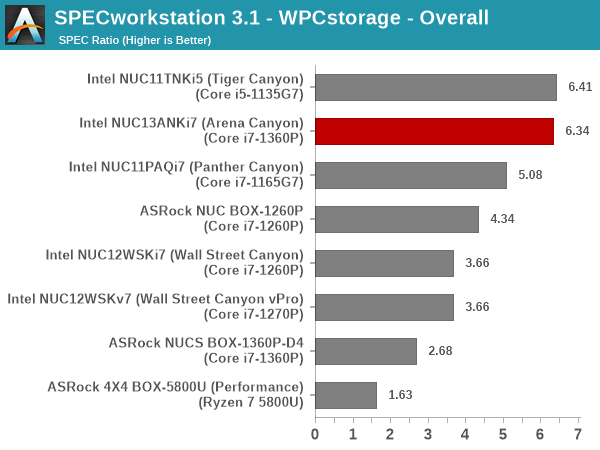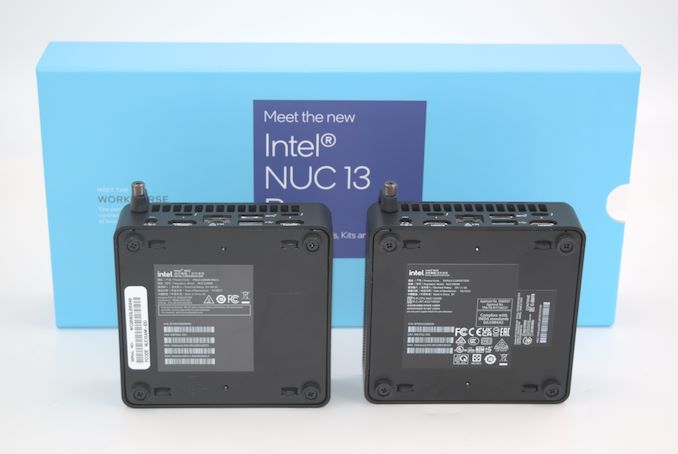Intel NUC 13 Pro Arena Canyon Review: Raptor Lake Brings Incremental Gains
by Ganesh T S on March 27, 2023 9:00 AM ESTMiscellaneous Aspects and Concluding Remarks
Networking and storage are aspects that may be of vital importance in specific PC use-cases. The Intel NUC13ANKi7 (Arena Canyon) comes with the Wi-Fi 6E AX211 WLAN card that also includes Bluetooth 5.3 support. On the wired front, the Intel I226-V controller backs up the 2.5 Gbps RJ-45 port. Dual LAN options are available in select Arena Canyon NUCs, but not in the specific SKU that we looked at today.
On the storage side, we have seen that UCFF PCs typically struggle with PCIe 4.0 x4 NVMe SSDs due to the lack of an effective thermal solution. We saw in the previous section that the temperature profile of the Samsung PM9A1 SSD is quite reasonable under stress. From a benchmarking perspective, we expect the SSD to deliver good scores without throttling in the WPCstorage test of SPECworkstation 3.1. This benchmark replays access traces from various programs used in different verticals and compares the score against the one obtained with a 2017 SanDisk 512GB SATA SSD in the SPECworkstation 3.1 reference system.
| SPECworkstation 3.1.0 - WPCstorage SPEC Ratio Scores | |||

The graphs above present results for different verticals, as grouped by SPECworkstation 3.1. The storage workload consists of 60 subtests. Access traces from CFD solvers and programs such as Catia, Creo, and Solidworks come under 'Product Development'. Storage access traces from the NAMD and LAMMPS molecular dynamics simulator are under the 'Life Sciences' category. 'General Operations' includes access traces from 7-Zip and Mozilla programs. The 'Energy' category replays traces from the energy-02 SPECviewperf workload. The 'Media and Entertainment' vertical includes Handbrake, Maya, and 3dsmax. Given that the comparison is between a wide range of SSDs in the systems - including both Gen 3 and Gen 4 NVMe, the relative numbers for most workloads are not surprising. As expected, the top two spots are taken up by the Gen 4 x4 high-end Samsung PM9A1 in the Arena Canyon NUC and its direct-to-consumer equivalent (980 PRO) in the Tiger Canyon NUC. Both deliver similar numbers within permissible run-to-run variations.
Closing Thoughts
The NUC 13 Pro Arena Canyon lineup is one of Intel's most comprehensive offerings in the UCFF space for business use-cases. A decade of experience listening to customers and analyzing deployments has allowed the company to produce a system with just the right mix of hardware and software features for different domains. The NPSS software feature for digital signage applications addresses some of the pain points inherent in existing solutions. Addition of a powerful processor in the background enables these displays to bring intelligence into the mix and scale well beyond being dumb terminals.
Despite not being the first to market with a Raptor Lake-P UCFF PC, Intel has managed to make the Arena Canyon NUC stand out. The system BIOS has been optimized to increase power efficiency without sacrificing performance. The sheer number of SKUs ensure that there is a system fulfilling the targeted use-cases for every desired price point.
Intel's Raptor Lake-P is quite close to Alder Lake-P architecturally. The core counts, cache sizes, and heterogeneous combinations are pretty much equivalent. Under such circumstances, it is indeed surprising that just process advancements have enabled Raptor Lake-P to provide satisfactory improvements in performance as well as power efficiency over Alder Lake-P.

NUC 13 Pro Arena Canyon NUC (L), NUC 12 Pro Wall Street Canyon NUC (R) - Hard to Differentiate
Positives aside, it is puzzling to see Intel not taking the lead in bringing DDR5 SODIMM support into the UCFF space. The similarity of the I/Os and board features to the Wall Street Canyon NUCs is also a bit of a concern. While we do not have concrete pricing information yet, online retailer listings seem to place it in the same ballpark as that of the Wall Street Canyon NUCs. Under such conditions, it is difficult to see why anyone would prefer the NUC 12 Pro units over the NUC 13 Pro - particularly when the former is slated to be in the market for the foreseeable future. Intel could have put in some more differentiation between the two - say, allowing in-band ECC to be enabled, or more Thunderbolt 4 ports, or adding a SD card slot, or even just changing the retimers to enable USB 3.2 Gen 2x2 20 Gbps support. Those could have justified a premium and allowed the Wall Street Canyon NUCs and Arena Canyon NUCs to coexist in the market.
The wide range of SKUs, longer life-cycles, and better performance as well as energy efficiency over the previous generation are bright spots for the Arena Canyon NUC lineup. The NUC 13 Pro family comfortably delivers upon its promise, but there exists a nagging suspicion that Intel has deliberately set the bar low this time around.










46 Comments
View All Comments
heraldo25 - Tuesday, March 28, 2023 - link
Why doesn't this type of PC ship with a USB C power adaptor? It would be ideal for travelling.meacupla - Tuesday, March 28, 2023 - link
Some NUC-like mini PCs do ship with a USB-C power connector.I can't say for certain, but I would guess it's because the manufacturer doesn't want you accidentally plugging in a <60W USB PD power adapter that cannot output 20V.
Most of these mini-PCs and laptops use a 19V barrel adapter.
There are also >60W multi-port USB-C power adapters will temporarily power down all ports when it detects a new device was plugged in.
It's just really difficult to deal with all possible hardware combinations, and I can see it being more trouble than it's worth.
Laptops are more forgiving with power loss, because they have batteries.
timecop1818 - Sunday, April 2, 2023 - link
They could ship it with a 65W USB-C PD adapter like HP and Dell laptops come with. But I'd rather they kept the barrel plug because wasting one USB C port on power is pretty lame.PeachNCream - Tuesday, March 28, 2023 - link
Suggestion - The opening paragraph is obviously a copy-paste from previous NUC articles. I get it that writers have a template and just fill in details at this point, but it just sets a tone for the article with regular readers as yet another hollowed out, low effort, assembly line thing that Anandtech used to not do, but seemingly does these days to toss reviews out the door. Variation would be helpful in the canned opener to mitigate some of that.Oyeve - Wednesday, March 29, 2023 - link
I have been buying Beelink mini PCs for my company this year and they are phenomenal for dollar value. Cost around 200-300 (depending on sales) and the model I chose for my users are the 16gb, windows 11 pro with AMD Ryzen 7 4700U and 500GB Kingston NVME drives. You really can't beat that price.timecop1818 - Sunday, April 2, 2023 - link
Yeah but then you're stuck with AMD